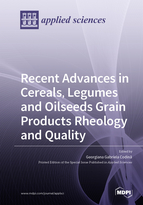Recent Advances in Cereals, Legumes and Oilseeds Grain Products Rheology and Quality
A special issue of Applied Sciences (ISSN 2076-3417). This special issue belongs to the section "Food Science and Technology".
Deadline for manuscript submissions: closed (30 November 2021) | Viewed by 88754
Special Issue Editor
Interests: cereal products; rheological properties; sensory analysis; functional foods
Special Issues, Collections and Topics in MDPI journals
Special Issue Information
Dear Colleagues,
The issue focuses on research advances related to rheology and quality of grain products from cereals as wheat, barley, millet, oats, rice, sorghum, etc, legumes (lentils, peas, beans, etc.), oilseeds (flax, hemp, sunflower, etc.), pseudocereals (quinoa, amaranth, buckwheat) and others. In the last decade a huge development has been noticed in the grain products rheology field measurements due to their impact on their quality. Nowadays, rheological parameters are an important key in quality control during grain products processing and preservation being related to the functional and compositional quality of grains and their products. The issue focuses on papers advancing original research and review papers at the interface between rheological properties of grain products and other aspects such as grains or products composition, functional and nutritional characteristics, microstructure, textural and sensorial analysis along with new instrumentation and methodologies relating to these areas.
Prof. Dr. Georgiana Gabriela Codină
Guest Editor
Manuscript Submission Information
Manuscripts should be submitted online at www.mdpi.com by registering and logging in to this website. Once you are registered, click here to go to the submission form. Manuscripts can be submitted until the deadline. All submissions that pass pre-check are peer-reviewed. Accepted papers will be published continuously in the journal (as soon as accepted) and will be listed together on the special issue website. Research articles, review articles as well as short communications are invited. For planned papers, a title and short abstract (about 100 words) can be sent to the Editorial Office for announcement on this website.
Submitted manuscripts should not have been published previously, nor be under consideration for publication elsewhere (except conference proceedings papers). All manuscripts are thoroughly refereed through a single-blind peer-review process. A guide for authors and other relevant information for submission of manuscripts is available on the Instructions for Authors page. Applied Sciences is an international peer-reviewed open access semimonthly journal published by MDPI.
Please visit the Instructions for Authors page before submitting a manuscript. The Article Processing Charge (APC) for publication in this open access journal is 2400 CHF (Swiss Francs). Submitted papers should be well formatted and use good English. Authors may use MDPI's English editing service prior to publication or during author revisions.
Keywords
- grain cereals
- grain legumes
- grain oilseeds
- pseudocereales
- rheological properties
- microstructure analysis
- textural properties
- processing
- health benefits
- nutritional value
- new products development-derived products
- consumer acceptance






